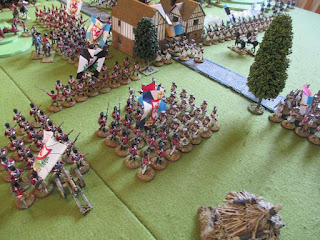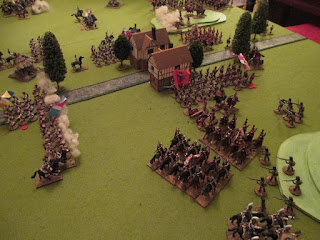The final action in my Napoleonic "imagi-nation" campaign - the Battle of Teckel-Le-Gtand. The Nemeans, following their so far successful pre-emptive strike into Arcadia - to forestall an invasion by the latter of Nemea - have made a final lunge for Collineville, the regional town. They encountered an Arcadian force moving to block their advance. An encounter battle ensued, with both sides sending in troops off the line of march. Victory went to the Nemeans, but it was a very pyrrhic one, as their losses were twice those of the Arcadians, and the latter won "on points" as a result of the casualties they inflicted, even though they did not secure any of the objectives. The result meant that the Nemeans abandoned their effort to seize Collineville and withdrew to the frontier unmolested. However, the campaign had been a success for them as it had completely disrupted any attempt by the Arcadians to invade Nemea.
The rules are "Old Style", based upon C.Grant's Napoleonic rules, adjusted to fit a 6 feet by 4 feet table and 24 figures infantry units, 12 figure cavalry units and one gun and 4 crew artillery batteries. The figures are mostly metal Hinchliffe 25mm, some metal 25mm Essex, and 28mm Perry and Victrix and plastics, plus a few odds and ends. The Nemeans (Prussian-influenced) are in red or black uniforms, the Arcadians (French-influenced) in white, yellow or light blue. Flags are homemade.
The battlefield - hills are steep, ridges gentle, woods passable only to infantry.
After a few turns, both sides are rushing troops forward to engage.
The Nemean No.1 Uhlan Regiment (ex-Hinchliffe French Guard Lancers).
The Nemean No.2 Reserve Light Dragoon Regiment (made from the spares box!), with No.7 Musketeer Regiment in the background. "Pavée" roads give a move bonus to units in column of route.
The Nemean No.1 Reserve Musketeer Regiment.
The Arcadian 2nd Cavalry Regiment (Dragoons).
The Arcadian 6th Cavalry Regiment (Chasseurs-a-Cheval).
Not the best formation for the Arcadian cavalry, being overlapped immediately! Light Cavalry against lancers does not bode well either!
The Arcadian light cavalry are about to break and flee the table, having been pushed back twice in succession by the lancers.
The Nemean No.5 Musketeer Regiment.
A Nemean general and his ADC. The general is an old Hinchliffe "one piece casting" or OPC, as they were referred to in the catalogue.
The Arcadian 3rd Grenadier Regiment - all grenadier and light infantry regiments are 16 figures strong.
The opposing forces about to enter Teckel-Le-Grand:
the fight for the village between the two units went on for most of the battle.
The Arcadian 2nd Regiment, Foreign Legion, their brigade commander and his ADC in the background.
The Arcadian 1st Light Infantry Regiment -r.in close formation and delivering a volley to scare off some Nemean cavalry that was hovering nearby, rather than their more usual dispersed open order.
Column vs. line!
After two volleys from the Arcadian grenadiers as they approached, the Nemean musketeers
failed to charge home.
The Arcadian 4th Cavalry Regiment (Cuirassiers) with their brigade commander and his ADC.
The Nemean No.1 Heavy Dragoon Regiment - very old Hinchliffe figures.
Both sides now have all their units on the table.
My version of the famous "roundshot stick" - in this case only 48" long, owing to my smaller table. The moveable is marked for 6pdr and 12pdr guns; the white section of the stick nearest the gun is the range for canister.
More columns vs. line - a better tactic for the attacker as the defenders have to spread their hits across more than one unit.
The red counters are used to indicate a unit has failed a morale test. In this case, the Nemean No.2 Reserve Musketeer Regiment has failed two tests in succession, hence the two counters. Three failures and the unit will be routing!
The opposing light infantry regiments face off in open order - at least 1" between individual figures.
The Nemean commander and his ADCs on North Hill.
My version of the "canister device" - again, this is shorter than the original and made from plastic sheet, rather than soldered wire. I also have a "shell device" and my own "shrapnel device".
The lost opportunity! For these rules, each unit's orders are written down at the start of the turn. As a result, the Arcadian 2nd Regiment, Foreign Legion was not given "Fire" orders, the Nemean heavy dragoons not expected to be given an order to ride past them so close. However, the latter did and got away with it!
Consequence - the 2nd Regiment, Foreign Legion hastily formed square to deter the Nemean heavy dragoons, while their own cavalry came up in support.
The white counter indicates that the unit has broken in rout after losing a mêlée.
More success for the Nemeans - another Arcadian unit breaks in rout and, in the background, an Arcadian battery is captured.
The Nemean success is about to unravel - the Foreign Legion Battery is about to blast them with a canister shot and an Arcadian counter-attack in the background forces is about to prove successful.
The canister shot proved devastating and the 50% rule came into effect - any unit which falls to 50% strength must automatically retire.
Cavalry clash on the far edge of the battlefield - it ended in a draw, both sides falling back to rally.
The squadron of the Arcadian 1st Cavalry Regiment (Lancers), Foreign Legion, seized the opportunity and charged routing Nemean infantry. Roll one 6-sided die per cavalryman, 4,5,6 kills. The infantry do not get any die roll in return! The Arcadian cavalry also captured their opponent's colour - 12 on a roll of two 6-sided dice.
The Arcadian 4th Cavalry Regiment (Cuirassiers) charged the Nemean light infantry with great success. Under the rules, light infantry in open order who cannot evade from a charge are automatically overrun.
The closing stage of the battle.














































































